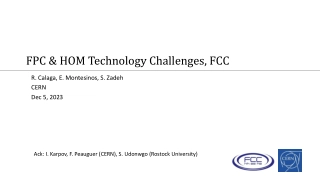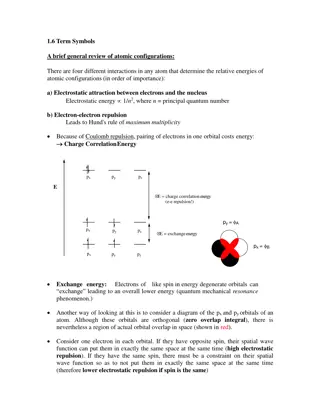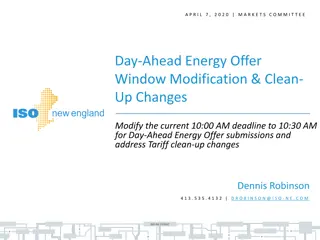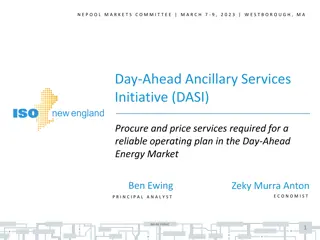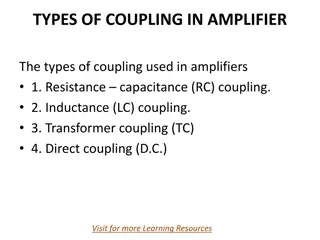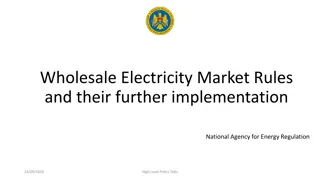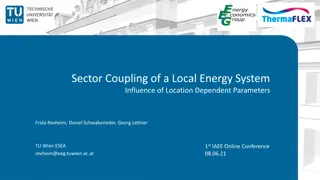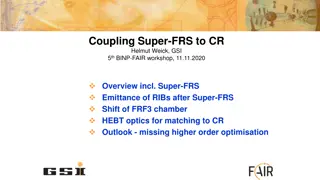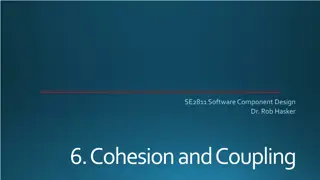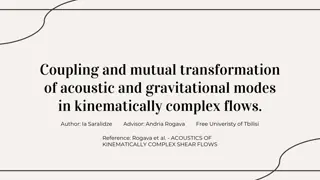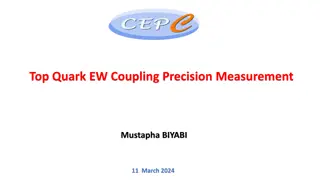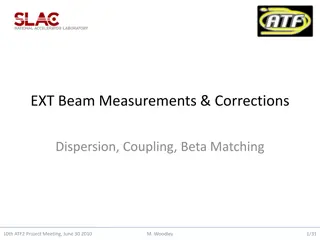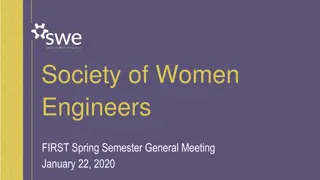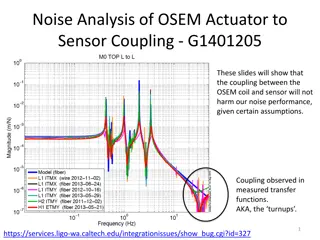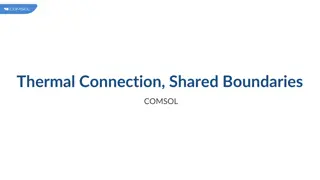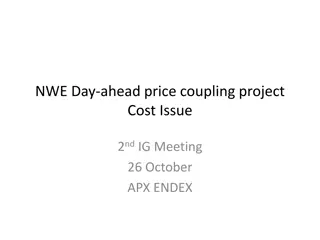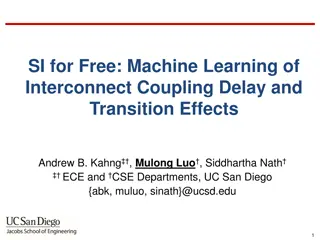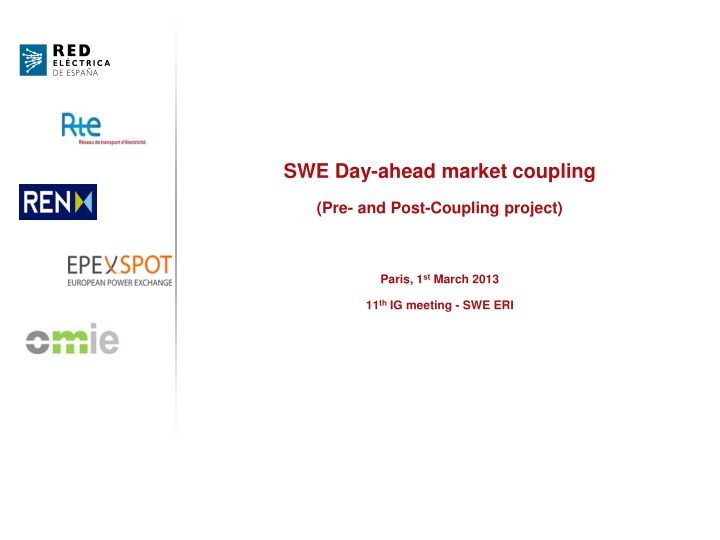
SWE Day-Ahead Market Coupling Project Overview
The SWE Day-Ahead Market Coupling project aims to connect the SWE region with the NWE region, following the European single internal market goals. Key aspects include high-level functional architecture, legal framework, regulatory evolutions, and project planning. The project's organization involves steering committees, working groups, and test activities to ensure successful implementation. The status includes signed cooperation agreements for design and forthcoming amendments for the implementation phase.
Download Presentation

Please find below an Image/Link to download the presentation.
The content on the website is provided AS IS for your information and personal use only. It may not be sold, licensed, or shared on other websites without obtaining consent from the author. If you encounter any issues during the download, it is possible that the publisher has removed the file from their server.
You are allowed to download the files provided on this website for personal or commercial use, subject to the condition that they are used lawfully. All files are the property of their respective owners.
The content on the website is provided AS IS for your information and personal use only. It may not be sold, licensed, or shared on other websites without obtaining consent from the author.
E N D
Presentation Transcript
SWE Day-ahead market coupling (Pre- and Post-Coupling project) EPEX Logo Paris, 1stMarch 2013 11thIG meeting - SWE ERI http://www.omel.es/files/framework_logo.jpg
Agenda 1 Project overview 2 High Level Functional Architecture 3 Legal framework and regulatory evolutions 4 Project planning http://www.omel.es/files/framework_logo.jpg EPEX Logo 2
Reminder: background of SWE market coupling Project objective: Day Ahead market coupling of the SWE region to the NWE region, based on PCR solution XXI Florence Forum: European single internal market by 2014 10thIG meeting of the SWE ERI (14/05/2012 in Paris): mandate to enter in a project phase through the signature of a Cooperation Agreement between the parties to specify Pre- and Post-Coupling (PPC) arrangements, analyze impacts and changes to be made and prepared for implementation 6th SG meeting of the SWE ERI (25/10/2012 in Madrid): first report EPEX Logo http://www.omel.es/files/framework_logo.jpg http://www.omel.es/files/framework_logo.jpg EPEX Logo 3
Reminder: the SWE project organization The SWE Organization comprises: SWE High Level Meeting (HLM) - The Steering Committee ( SC ) which contains representatives from all project parties and is the unique body entitled to make decisions PMO - The General Working Group ( GWG ) is in charge of the day-to-day management of the project SWE PPC PROCESSES STEERING COMMITTEE (SC) (REE) - The Legal Working Group ( LWG ) is in charge of preparing the necessary agreements between the SWE parties to operate the Market Coupling and identifying the required regulatory changes - The ( PTWG ) is in charge of producing the procedures and of organizing and carrying out the SWE test activities Procedure and Testing Working Group GENERAL WORK GROUP (OMIE) Implementation of PCR solution in the region (algorithm, associated IT systems) is being developed by PXs PROCEDURES AND TESTING WORKING GROUP (PTWG) (EPEX Spot/OMIE) LEGAL WORKING GROUP (LWG) (EPEXSpot) http://www.omel.es/files/framework_logo.jpg EPEX Logo 4
The SWE-PPC project status A Cooperation Agreement has been signed for the design phase and an amendment for the implementation phase is to be finalized soon for its signature The design phase for Pre-Coupling, Post-Coupling and Exceptional Situations is almost finalized The design of Fallback solutions (the exceptional situation when there is a decoupling) is currently being analyzed. Two options are under evaluation: daily shadow (explicit) auctions aligned with CWE/NWE and deemed flow zero (allocation in ID timeframe) A first set of regulatory changes which are needed in Spain and Portugal has been provided to the relevant National Regulatory Authorities and is waiting for publication. These changes include the modification of Gate Closure Time of the DA Iberian market (MIBEL) to 12:00 (CET) Preparation of the other regulatory changes (e.g. PCR algorithm and adaptation of Spanish Operation Procedures to PPC process) is in process http://www.omel.es/files/framework_logo.jpg EPEX Logo 5
Agenda 1 Project overview 2 High Level Functional Architecture 3 Legal framework and regulatory evolutions 4 Project planning http://www.omel.es/files/framework_logo.jpg EPEX Logo 6
High Level Functional Architecture Pre-coupling and post-coupling - Pre-coupling describes the process of sending and validating the ATC/NTC needed for the Coupling. - Post-coupling describes the process of checking market results and communicating the scheduled cross border exchanges between the different bidding zones and the settlement and billing and payment of the congestion rent Exceptional situations and Fallback - Exceptional situations procedures explain how to manage: Absence of transfer capacity information for a border in the last permitted moment Non-coherent transfer capacity information for a border in the last permitted moment - Fallback is the process initiated in case of: Impossibility of solving the European Coupled market. Need of a Fallback procedure for the Spain France border in decoupled situation For Portugal and Spain, no fallback will be investigated as OMIE will ensure delivery of schedules on the border http://www.omel.es/files/framework_logo.jpg EPEX Logo 7
High Level Functional Architecture Pre-coupling Parallel sending of ATC values TSOs common system EPEX RTE ATC Fr-ES Matching PCR ATC Fr-ES REE ATC ES-P Matching rules OMIE Matching REN ATC ES-P http://www.omel.es/files/framework_logo.jpg EPEX Logo 8
High Level Functional Architecture Post-coupling, validation of results Parallel validation of results Results REN OMIE Validation Validation Results REE Validation PCR EPEX TSOs common system RTE Results Validation http://www.omel.es/files/framework_logo.jpg EPEX Logo 9
High Level Functional Architecture Post-coupling, congestion rent 50% share of day-ahead rent, involvement of CASC for RTE Explicit nomination for the French side only OMIE REE 50% DA rent Agreement to share the rent, settlement bank 50% UIOSI 50% LT rent 50% DA rent + 50% LT rent 50% UIOSI CASC/CRDS RTE EPEX 50% DA rent 100% UIOSI 100% LT rent MPs CRDS: Congestion Rent Distribution System http://www.omel.es/files/framework_logo.jpg EPEX Logo 10
High Level Functional Architecture Exceptional situations The following cases are being investigated by the GWG Situation description Case 1 : No ATC received No ATC value from REE and RTE No ATC value from REE and REN o o Case 2 : One ATC value missing ATC from REN and no ATC from REE ATC from RTE and no ATC from REE ATC from REE and no ATC from REN ATC from REE and no ATC from RTE o o o o Case 3 : Mis-matches ATC values Different ATC values from REE and REN Different ATC values from REE and RTE o o The following fallback solutions are discussed: Shadow auctions Deemed flow zero - Intraday allocation http://www.omel.es/files/framework_logo.jpg EPEX Logo 11
High Level Functional Architecture Fallback solutions for coupling Option 1: Shadow auctions Explicit shadow auctions are carried out for allocating physical capacities for the following day Taking into account the results of this explicit allocation of capacities, Market Parties have to modify their bids in the day-ahead market or make bilateral contracts. PXs should reopen their orders books once the explicit auctions have been carried out This mechanism is similar to the daily explicit auction currently in place on the France-Spain border This mechanism is currently in place as the standard fallback solution in CWE coupling PROS CONS Time necessary for carrying out Shadow auctions may not be sufficient: need for a more detailed analysis of timings Market based mechanisms Financial risk is not carried by TSOs nor PXs Need of proper reaction by MPs (risk of unacceptable peak prices if some bids are not duly updated in DA market - past experience not always positive) Market Parties can decide the use of capacity (direction, volume and price), depending on their needs Need to take into account the delays and implications on the following markets in Spain (implicit nomination, generation scheduling ...) Solution known by market parties (similar to current mechanisms and already in place on other borders) http://www.omel.es/files/framework_logo.jpg EPEX Logo 12
High Level Functional Architecture Fallback solutions for coupling Option 2: Deemed flow zero - Intraday allocations A volume of zero is given as capacity to be allocated in the matching process between FR and ES for the resolution of the pricing algorithms in the decoupled markets (long term capacities are taken into account in any case) The capacity that is not given in the DA market is offered later on in the intraday timeframe, whatever the allocation method is in place. MPs may need to update their bids in the DA market once the information about the initiation of fallback is given. In this case PXs would then reopen their order books PROS CONS Timing: the pricing algorithm can be easily run with a zero capacity between bidding areas. Risk of price spread spikes in the day-ahead markets when no capacity is allocated in DA Robustness: this solution seems easier to implement and has less operative impact on MPs, compared to shadow auctions No congestion rent in DA Non market-based solution Avoidance of some financial risk to TSOs and PXs as the D-1 congestion rent is zero (cannot be negative) Can be a last resort solution if shadow auctions fail http://www.omel.es/files/framework_logo.jpg EPEX Logo 13
Agenda 1 Project overview 2 High Level Functional Architecture 3 Legal framework and regulatory evolutions 4 Project planning http://www.omel.es/files/framework_logo.jpg EPEX Logo 14
Legal structure for the operational phase An analysis of the necessary contractual and regulatory developments to start the SWE coupling is required: Pre-coupling Post-coupling The common aim of all parties is to stick as much as possible to the existing contractual, statutory and regulatory arrangements However in any case, some points do require contractual provisions The proposed legal framework is based on a light framework agreement and bilateral contracts http://www.omel.es/files/framework_logo.jpg EPEX Logo 15
High Level legal framework 1 : Light framework agreement for all parties : Bilateral contracts 2 3 4 1 3 Statutory and regulatory provisions http://www.omel.es/files/framework_logo.jpg 4 PCR agreements EPEX Logo Contractual relationship 2 No contractual nor regulatory provisions implemented http://www.omel.es/files/framework_logo.jpg EPEX Logo 16
Option 2: detailed presentation All parties light framework agreement 1 Communication Non-disclosure obligations Intellectual Property Rights (IPRs) High level description of procedures Congestion rent waiver (only for market results and decoupling to be evaluated in a further stage to be discussed at further stage) Governance Change control procedure Light liability provisions (exclusion provisions but no single liability cap). of indirect damages, specific OMIE EPEX : PCR RTE EPEX OMIE REE / REN 4 2 3 PCR interregional coupling to be added : pre-post coupling regional procedures. agreements procedures provide for Operations Daily operation procedures Pre- and post-coupling fall-back exceptional situations Firmness of the ATC the http://www.omel.es/files/framework_logo.jpg Daily operation procedures matching of the ATC decoupling fall-back Obligation to ensure consistency on operational side arrangements among themselves and with PCR + liability provisions of PCR PCR agreements http://www.omel.es/files/framework_logo.jpg Regulatory framework of all bilateral EPEX Logo EPEX Logo http://www.omel.es/files/framework_logo.jpg EPEX Logo
Status of operational and regulatory changes Change of Gate Closure Time of the Iberian market to 12:00 (CET) A set of regulatory changes needed in Spain can be identified High level regulation (Ministerial Order 4112/2005) MIBEL Markets Rules and Operational Procedures in Spain (e.g. tick size ) FR-ES Interconnection rules (IFE Rules) Cooperation Agreement RTE-REE for the management of the interconnection A set of regulatory changes needed in Portugal can be identified Manual de Procedimento da Gest o Global do Sistema and corresponding Avisos; Agreement between REN and OMIE. Implementation of these changes before November 2013 is on the critical path for market coupling go live The signature of all needed agreements between parties is a critical condition for program progress http://www.omel.es/files/framework_logo.jpg EPEX Logo 18
Agenda 1 Project overview 2 High Level Functional Architecture 3 Legal framework and regulatory evolutions 4 Project planning http://www.omel.es/files/framework_logo.jpg EPEX Logo 19
The SWE-PPC project planning Preliminary SWE Project planning: - The remaining design activities are mainly the finalization of the design, the extension of the project to implementation, the proposal of the regulatory changes and contractual developments needed to implement PPC processes. It is foreseen to finish the design phase in March 2013 and to start the implementation phase of the project with IT developments and testing - It is the objective of all SWE parties to participate in the NWE integration tests in June 2013, provided that all local SWE tests are completed successfully at that date. As PCR members EPEX and OMIE already participate in the PCR testing - The Florence Forum conclusions of the 20th confirmed that the European community supports all parties to proceed speedily, including the SWE region as soon as possible - The SWE project go-live date will be defined in a reasonable manner once the process is evaluated in detail together with NWE and 21stNovember 2012 meeting have SWE parties have assessed two options for the planning (cf. next slides). These planning options take into account coordination with NWE and include the assessment of temporary solutions for some specific processes http://www.omel.es/files/framework_logo.jpg EPEX Logo 20
Proposal of the high level planning Startup solution 2014 2013 Feb March April May June July Aug Sept Oct Nov Dec Jan Feb NWE Go live window Implementa tion preparation Reception of comfort letters (RTE) Design finalization Operators training MPs training Design approval Project implementation plan Main characteristic of this startup solution: Operational activities Signature of amendment to Cooperation Agreement for implementation Design approval Comfort letters Project implementation plan Sending of ATCs on FR/ES only by REE Procedures refinement Aspects to be taken into account: Contractual framework drafting Contracts drafting Reduced time for industrialized post coupling testing (including nominations) No room for contingency Regulatory modalities for this specific interim solution to be defined IT Specs IT developments PX s IT IT developments Specs..Post C. PX s Post Coupling IT developments TSO s IT Specs..Post Coupling TSO s Post Coupling IT developments Local testing Master test plan definition Master test plan Connectivity testing Sanity, integration testing Procedural and acceptance testing Testing activities Participating in PCR/NWE testing Coordination with NWE testing activities Regulatory approval(s) Public consultation(s) Local regulation evolutions/changes Regulatory evolutions EPEX Logo Auction rules evolution http://www.omel.es/files/framework_logo.jpg
Proposal of the high level planning Final solution http://www.omel.es/files/framework_logo.jpg EPEX Logo 22

